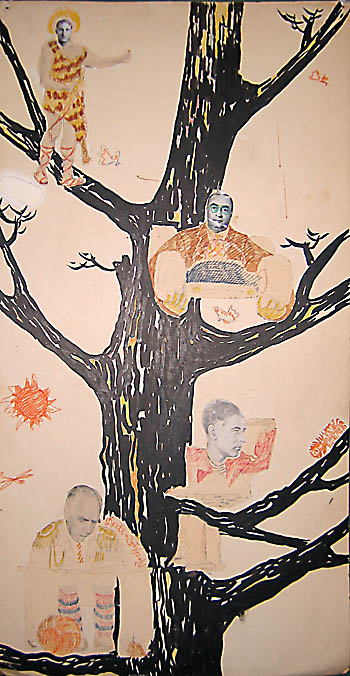
This is a picture from the room of Theoretical Dept, demonstrating a humorous genomic tree (from Niels Bohr, via Lev D. Landau, to Veniamin G. Levich, and then to Revaz R. Dogonadze). Levich headed the Dept until 1972, when he applied for permission to leave USSR. Valentin S. Krylov served as a head during the 1972-1985 period.
The complete list of the staff was put together by late Alexander M. Kuznetsov, who was the last head of Theoretical Dept (later Theoretical sector) before it was closed.
Major part of the Dept staff originated from Moscow Inst of Engineering Physics, where Levich taught in 1954-1964, and later from the Faculty of Mechanics and Math in Moscow State University, where Levich founded a chair of chemical mechanics in 1966. Revaz Dogonadze also taught there in 1969-1972. He joined Levich as PhD student in the Inst of Physical Chemistry in 1955, and remained the most significant person of the Dept until his return to Tbilisi in 1978. There are Kuznetsov’s notes about Dogonadze (1986) and the memorial special issue of the Journal of Electroanal. Chem. (1985), with an Introductory text containing the list of Dogonadze’s publications. Here is his fundamental review “Theory of molecular electrode kinetic” published in “Reaction of molecules at electrodes” edited by N.S. Hush (N.-Y.: Wiley, 1971, p. 135-227).
From Levich’s Introduction to the second edition of his “Physicochemical Hydrodynamics” (1959), we can judge that the earliest Dept members besides Dogonadze were Yuryi A. Chizmadzhev, Valentin A. Kiryanov, Vladislav Yu. Filinovskyi, and Boris M. Grafov.
The most known topics of Theoretical Dept are listed below, with the names of the people involved. Some names are mentioned several times, as there were numerous topical intersections. Biographical links and comments are included at the first mention.
Quantum mechanical theory of the elementary act of electron and proton transfer in polar media (Revas (Rezo) R. Dogonadze (1931-1985); Alexander M. Kuznetsov (1938-2009); Yuri A. Chizmadzhev (1931-2022); Yurii I. Kharkats (1941-1999); Ernst (Eric) D. German (continued in Technion, Haifa); Mikhail A. Vorotyntsev (continued in Bourgogne Univ, Dijon, later returned to Moscow); Igor G. Medvedev (1949-2023); Mikhail V. Vigdorovich (currently in Tambov Univ); Vladimir V. Sokolov (left for Tohoku University, Sendai). This direction is sometimes named quantum electrochemistry, and an important part of physical electrochemistry as a whole. It is typically associated with the Russian theoretical school in the field of electrochemistry. In early 1970s, foreign scientists visited the Dept for long periods to work in this surrounding. In particular, Jens Ulstrup and Wolfgang Schmickler, who later became key persons in the theory of electrode processes, were among these visitors. The closest experimental colleague in the Inst was Lev I. Krishtalik (1927-2022).
Adsorption and the structure of charged interfaces (“double layer”) (Valentin A. Kir’anov (1926-1995); Valentin S. Krylov (1935-1985); Alexey A. Kornyshev (left for Jülich Res Ctr, then moved to Imperial College, London); Mikhail A. Vorotyntsev; Sergey N. Ivanov (left for private company). Early studies accented the discreteness-of-charge (Esin-Markov effect). An important long-term visitor working in this direction in early 1970s together with V.S. Krylov was Ron Fawcett (1939-2025).
Mass transport in electrochemical systems was a multifaceted topic, including the migration and convective diffusion issues (Vladislav Yu. Filinovskyi; Yuryi I. Kharkats; Valentin S. Krylov; Vladimir P. Vorotilin (who continued in the Inst of Applied Mechanics)). R.R. Dogonadze also started from this topic, considering application of RDE to complex reactions (here is his early article in Zhurnal Fizicheskoi Khimii. 1958. V. 32. P. 2437-2442). This branch also includes macrokinetics of the processes in porous media (Yuri A. Chizmadzhev (1931-2022); Vladislav S Markin (1936-2022); Yuryi G. Chirkov; Alexey A. Chernenko (1933-2007). These studies were closely related to fuel cell research, which was very active in Frumkin Inst starting from mid 1960s.
Theory of chemical reactors and gas phase reactions (Leonid (Len) M. Pis’men (continued in Technion, Haifa), Semen I. Kuchanov (1940-2016), Anatol M. Brodski (1927-2013)).
Bioelectrochemistry, understood as a branch of biophysics (Yuryi A. Chizmadzhev; Vladislav S. Markin; Artem (Tyoma) V. Sokirko (moved to IT, currently in US); Vassili Ph. Pastushenko (left for Humboldt Univ, Berlin, and later moved to J. Kepler Univ, Linz)). This direction of Theoretical Dept resulted in the appearance of a specialized Bioelectrochemistry lab in 1977, where a very important person was also Leonid I. Boguslavskii (1935-2013).
Electron photoemission at the metal/solution interface (Anatol M. Brodskii and Yuryi Ya. Gurevich (1939-1990)), in close collaboration with experimental groups of Viktor A. Bendersky (1937-2022), Yu. V. Pleskov, and Z.A. Rotenberg (1936-2013). This theoretical research later gave rise to a new direction, electrodynamics of charged interfaces (Anatol M. Brodskii; Michael I. Urbakh (Tel-Aviv University); Leonid I. Daikhin (Tel-Aviv University)). Simultaneously, some activities addressed the solvated electron (1987 review).
Solid electrolytes (Yuryi Ya. Gurevich; Yuryi I. Kharkats), mostly superionics. Gurevich’s 1988 Chapter co-authored with A.K. Ivanov-Shits is available. There are many later analogies with solid electrolytes in thermodynamics of electrochemical intercalation, as related to phase transitions.
Semiconductor electrochemistry (Viktor A. Myamlin (1924-?)), developed in close collaboration with Yuryi V. Pleskov, they co-authored a very famous book in 1965 (link to 1967 translation). Viktor Alexeevich Myamlin was the eldest staff member, who obtained his PhD from the Moscow Mechanical Institute (the precursor of the Moscow Institute of Engineering Physics) in 1953, under the supervision of Yakov A. Smorodinskyi (1917-1992).
Impedance and related non-stationary techniques (Boris M. Grafov), research developed in close collaboration with Evgeny A. Ukshe (1928-1993). Grafov&Ukshe book “Electrochemical circuits alternating current”, 1973, in Russian, can be read online.